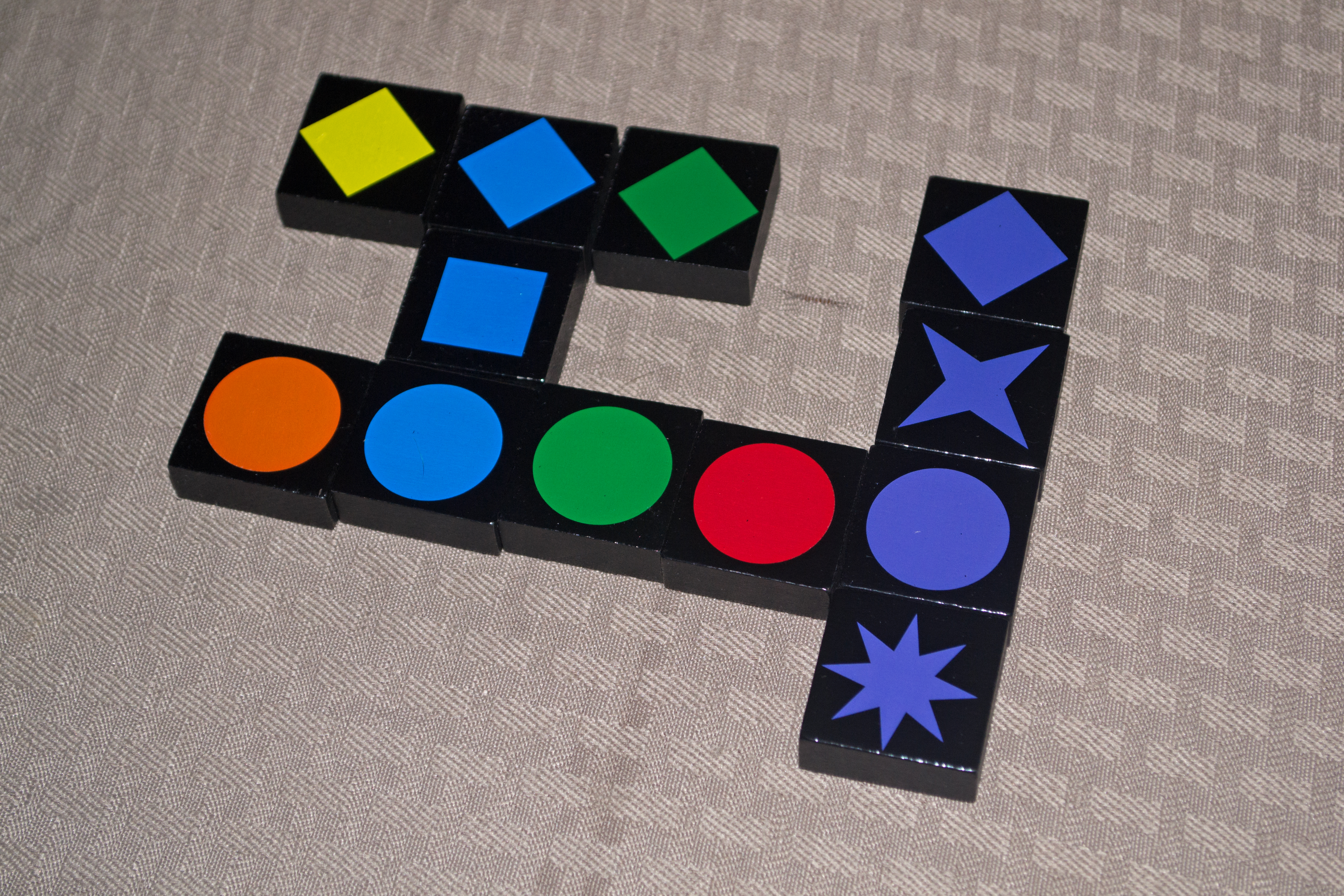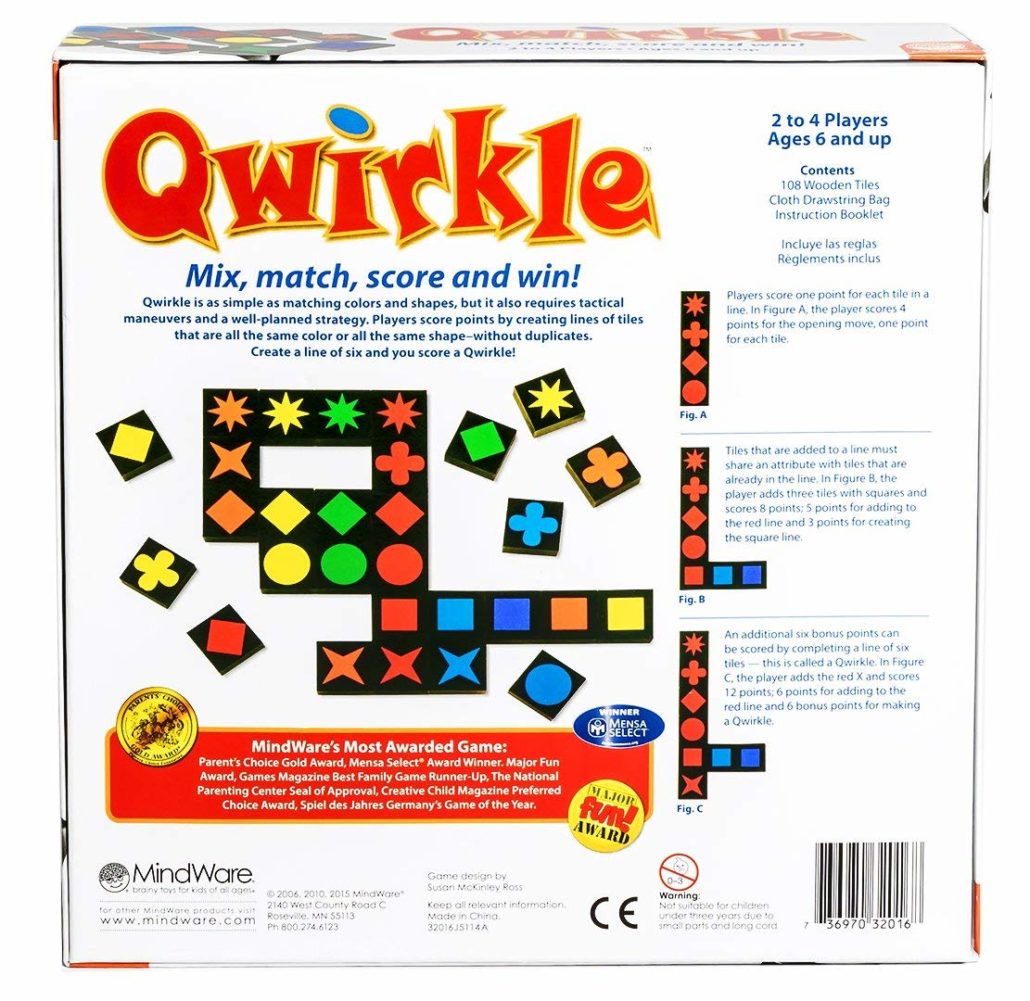

Each player randomly draws 6 tiles from the bag.Take 1 sheet of paper and 1 pencil (to note the score).

Somewhere between Scrabble, dominoes and Jungle Speed, Qwirkle consists of aligning tiles with symbols of identical shape or colour in order to create combinations that yield maximum points. MATERIALS: 108 tiles (3 times 36 different tiles: 6 shapes, 6 colors), 1 fabric bag Just making some spectacular play, using all the dice on one turn, completing a row and adding on to two or even three more all at the same time – is so wonderfully satisfying that winning, dare I say it, seems almost besides the point.OBJECTIVE OF QWIRKLE: The objective of Qwirkle is to collect more points than other players by aligning tiles with colored symbols. In fact, we find the F U N so Major that we have come to play more for the glory than the score. Fun that even, from time to time, makes you laugh. For kids (probably at least 8 years old). If you own neither, you should consider buying either. The symmetry of both versions (6 colors, 6 shapes), the visual, conceptual puzzles they both present make both games endlessly fascinating.
#Qwirkle rules double qwirkle portable#
If you already own one, you will probably want the other, not because it’s better or more portable or cuter, but because it’s unique, and it’s uniquely fun. The more you play, the deeper your appreciation for the strategic implications of playing with dice, and the clearer it becomes to you that Qwirkle Cubes (the dice game) really can’t be compared to Qwirkle (the tile game), even though the colors and shapes and rules for matching and the designer (Susan McKinley Ross) are the same. So you ponder, and roll, and combine, and add to the ever-unfolding matrix (which is conveniently less table-top-consuming than the matrix that ever-unfolds when playing Qwirkle (the tile game). But equally true, with the re-rolling option, you might be able to change the shape. True, you can do nothing about the color of the symbols. And, in being able to re-roll your dice, you find yourself with the yet further thought-provoking opportunity to see what fate has so far hidden from you. Now that you can see the other players’ hands, you have everso much more to analyze. But that very openness is thought-provoking, to say the least. Unlike that other Qwirkle game to which we are not referring, there is nothing hidden. You see, everyone can see what everyone has. And herein lies the wrinkle of conceptual delight that, dare we compare, is new, even to those who play Qwirkle (the tile game). Ah, so simple, so easy to learn, and yet, so rife with strategic significance and tactical titillation.īefore you take your turn, you may, if you so desire, re-roll any or all of your dice. One might be tempted to compare it to something a game of rummy played Scrabble®-fashion. Do you notice perhaps a pattern? Are some of your dice of the same color, and each of those dice showing a different shape? Are more of your dice all showing the same shape, and each a different color? Whoever has the longest of either of the aforementioned goes first.įrom then on, you take turns, adding to the grid in crossword-fashion, gathering points for the number of dice you place, and for any adjacent rows or columns of dice you add your dice to, garnering yet 6 more points should you complete a row or column of same-color, different shape symbols. Perhaps you give them one more roll, just to celebrate the randomness of it all.

So you, and another, or perhaps 2 or 3 others, take turns extracting 6 dice from the bag.

And then you place all 90 of these smoothly finished colorful cubes into the bag, as instructed. And, further, how there are six different colors of dice. You roll them, observing how each die has a different shape on each face, all of the same color. You fondle them, because they, in their lovingly polished one-inch, wooden, dice-like way, almost beg you to do so. You release the cubes from their plastic wrappedness, allowing them to cascade onto the table and make a pleasingly muted woodish sound. Open the cleverly cube-like box and you find a sturdy cloth drawstring bag, under which are packaged 90 wooden cubes. Qwirkle Cubes comes in a Qwirkle Cubes box that is cleverly cube-like. But we shall set these temptations aside, for the nonce, at least. Setting aside the fact that Qwirkle (the tile version) has won the Major Fun Keeper Award, and resisting any attempt to compare Mindware’s Qwirkle (the tile version) to Mindware’s Qwirkle Cubes (the dice version), let us proceed as if there were no precedent, and treat Qwirkle Cubes for the unique game it really is.


 0 kommentar(er)
0 kommentar(er)
